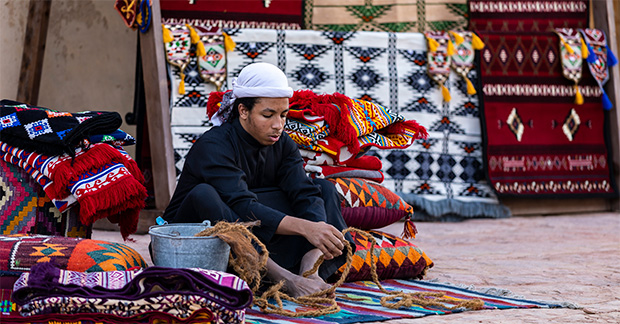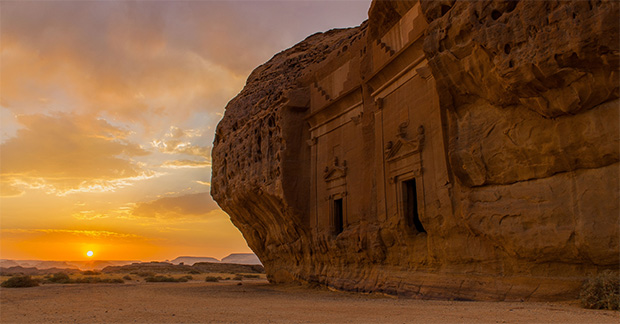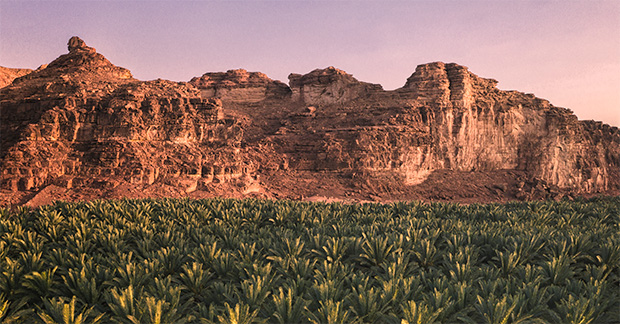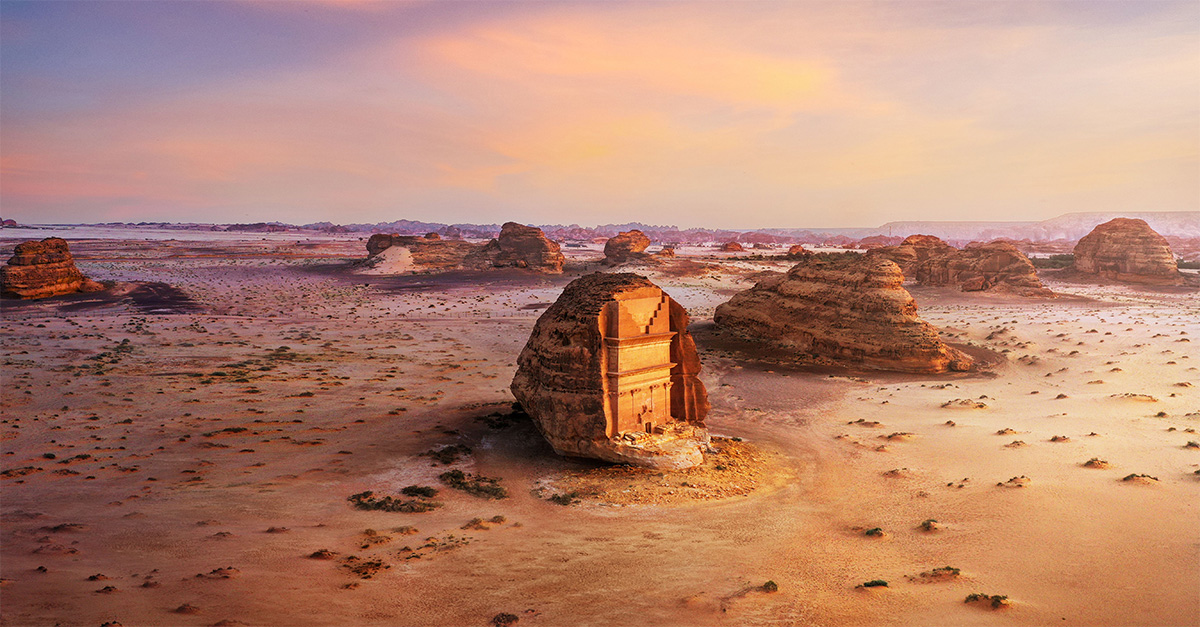You are viewing 1 of your 2 free articles
Here’s why AlUla could be Arabia’s next tourism hotspot
Untouched AlUla is awash with incredible sights, enriching culture and locals eager to share their heritage, discovers Charlotte Brook
Click here to download and save as a PDF
It feels like I’ve stepped onto another planet. The landscape is barren, scattered with towering rock formations casting obscure shadows on the desert floor, made more dramatic under the blazing Saudi Arabian sun. Everywhere I look, burnt-orange sandstone pillars take on different shapes: a gigantic elephant glows enchantingly at dusk, a guitar takes shape in the narrow crevice between two mountain peaks, a bowling pin juts over a sandstone outcrop.
Over millennia, the sun, wind and rain have sculpted AlUla’s landscape into a terrain that feels entirely otherworldly. And since this destination only opened to tourists in 2020, today’s travellers tread where few others have ventured before.
Given the opportunity to visit this mysterious region on a fam trip with operators Elegant Resorts and If Only and the Royal Commission for AlUla, I was intrigued – though like many, I had reservations about travelling to Saudi Arabia in light of the issues surrounding its social policies.
But I came to AlUla with an open mind, never expecting to be so completely captivated – a feeling shared by the agents I travelled with. We discovered not only a destination of stunning beauty and profound history but also a warm and welcoming environment, with locals eager to share their culture and ensure we felt safe and at ease.
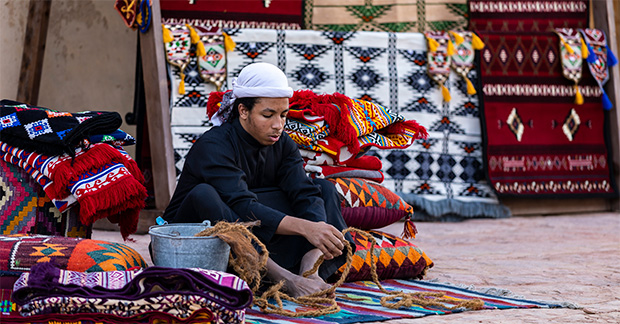
History of AlUla
Numerous ancient civilisations – including the Dadanites, Lihyanites, Nabataeans and Romans – have left their mark on AlUla. Their stories are etched into its long heritage, offering a unique opportunity to explore history that is still being uncovered and understood.
“The most important thing for travellers to do in AlUla is visit all the heritage sites, from the Old Town to Hegra to Dadan. Hearing the stories of the land here is mesmerising,” says Samah, a local rawi (guide) as she leads us through the Old Town, the first stop on our edifying journey through the region. Here, past and present collide as cobbled, labyrinthine streets and mud?brick buildings retain their 12th?century footprint, now transformed into a hub of bustling shops and restaurants.
In the following days, we explore AlUla’s fascinating historical sites, all reachable within less than an hour’s drive. At the Dadan excavation site, we walk through what was once a powerful oasis kingdom and important trading hub where Dadanite and Lihyanite people thrived as early as the second century BCE.
Here, merchants on the Incense Road exchanged precious goods such as frankincense, travelling from southern Arabia to the Mediterranean and beyond. Today, only around 5% of Dadan has been excavated, a glimpse of just how much there is yet to discover in AlUla.
These rich histories aren’t only told through artefacts. The Jabal Ikmah Valley – AlUla’s second Unesco World Heritage Site – is home to an ‘open library’ of intricate inscriptions adorning cliff faces and rocks.
Each carved?out image tells the story of settlers and travellers who passed through AlUla, the latter often writing to the Lihyanite god to request protection for their journey ahead. It feels surreal to see these engravings first hand, imagining the lives of the people who once stood in this place to leave their mark on the world.
Among the many wonders of AlUla, however, none are as archaeologically striking as the tombs of Hegra, Saudi Arabia’s first Unesco World Heritage Site. Like better?known Petra in Jordan, this necropolis was built by the powerful Nabataean kingdom, which dominated the region from about the fourth to the second century BCE.
Unlike Petra, however, Hegra isn’t crammed with crowds of tourists or souvenir stalls, so clients can absorb the jaw?dropping scale of these burial chambers in spine?tingling silence. Left almost undisturbed for nearly 2,000 years, Hegra’s 111 tombs are impressively well preserved, but the tomb of Lihyan, son of Kuza, is the real showstopper.
In AlUla, each sight seems more breathtaking than the last, but it’s understanding the history behind these landmarks that leaves visitors with a profound sense of awe.
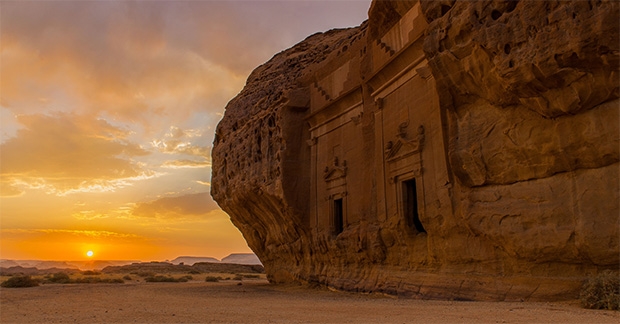
Investment in AlUla
As one of Saudi Arabia’s ‘giga?projects’, AlUla has received significant investment to enhance its appeal to travellers, from restoring the mud?brick buildings of the Old Town to opening several new resorts. The second phase – set to be completed in 2035 – includes the development of five heritage sites, a regenerated ‘cultural oasis’ and 10 million square metres of green and public spaces.
AlUla also plans to add 5,000 hotel rooms and a low?carbon tramway to improve connectivity.
A growing events calendar offers a window into the region’s culture through the AlUla Wellness Festival, arts festivals and concerts featuring well?known artists such as Lionel Richie and John Legend.
However, although the destination is increasingly setting itself up for tourism, AlUla still feels largely untouched and, for many, unheard of. But that is precisely its charm: visiting AlUla feels like being let in on a well?kept secret, one that is as surprising as it is enlightening.
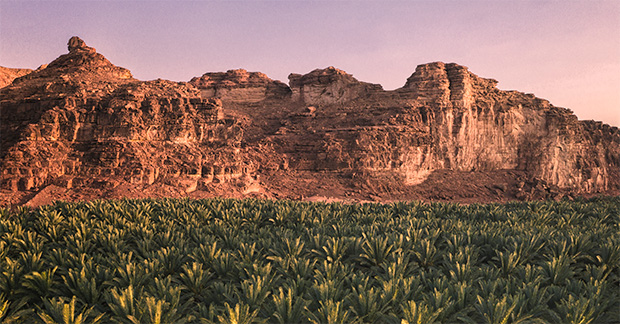
How tourism is changing AlUla
Given its position along the incense trading route and pilgrimage trail to Mecca, AlUla has always served as a crossroads of cultures. Now, with tourism on the rise, this spirit of cultural exchange continues as social hubs emerge for locals and tourists alike.
In the evenings, we stroll through the Old Town, browsing boutique shops selling scarves, jewellery and beauty products.
Soft music plays from speakers, lanterns glow along the streets and people gather in restaurants and cafes, creating an inviting, lively atmosphere. “Everyone is excited about how the Old Town is being revived and being able to share our culture with tourists,” says Samah.
The Oasis, a sprawling expanse of date palms, citrus trees and crops, is also becoming a social centre, with pop?up concerts, new dining venues and experiences such as cooking classes using freshly farmed produce. As we explore it on a heritage trail, another rawi, Atif, shares how the Oasis is impacting the community.
“It’s an amazing place for cultures to engage together. My wife and children come here all the time and meet with visitors. My child can now speak English because he engages with tourists in the Oasis,” he says.
It’s these conversations and interactions with local people that show AlUla not only offers a region steeped in ancient history and culture, but also a genuine warmth of hospitality that invites visitors to challenge their preconceptions. In a world where so few places feel genuinely undiscovered, it stands as a refreshing reminder that there are still hidden places waiting to be explored.
Book it
If Only offers a five-night Authentic Arabia: Discovering AlUla package from £9,019 per person, based on two sharing, including return flights and transfers, accommodation at Shaden Resort and Our Habitas, with meals and guided tours.
ifonly.net
Elegant Resorts’ five-night Discover AlUla: Incredible Culture and National Treasures package starts from £9,600 per person, based on two sharing, including flights, accommodation at Banyan Tree AlUla and Our Habitas AlUla, along with meals and guided tours.
elegantresorts.co.uk
Agents’ views

Debbie Wignall, Marple Travel
“I wasn’t sure what Saudi Arabia would be like, due to negative misconceptions, but I’m happy to have formed my own positive opinion. That’s mainly down to the lovely people and their great sense of humour. The scenery, too, is just spectacular. My highlight of the trip was flying across the desert in a hot-air balloon at sunrise.”
Lee Osborne, Club Voyages

“What surprised me about AlUla is that it feels very safe, and like a historically rich, aesthetically sublime bubble within Saudia Arabia. I’d tell my clients to cast aspersions aside and experience the local charm and hospitality for yourself. Plus, a teetotal holiday is surprisingly achievable and the juices are delicious, so you really don’t miss the alcohol (that much!).”
Where to stay in AlUla
Spend: Shaden Resort
This Accor-owned hotel is home to 121 rooms and villas surrounded by spectacular sandstone cliffs and dotted with date palms. The property is suited to families with its expansive swimming pool, activities including movie nights under the stars and varied dining options at restaurant La Palma.
all.accor.com
Splurge: Our Habitas AlUla
This luxury property is a standout among the area’s hotel offering. It features 96 tented villas scattered among the canyons of Ashar Valley, along with a separate glamping experience of 45 Airstream trailers a short distance away.
Daily activity programmes include sound bathing and meditation classes, plus a stargazing experience that is quite literally out of this world.
ourhabitas.com
PICTURES: Royal Commission of AlUla

